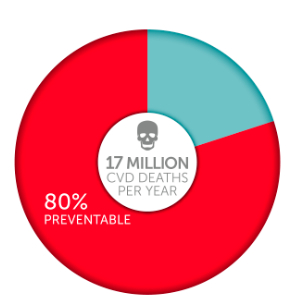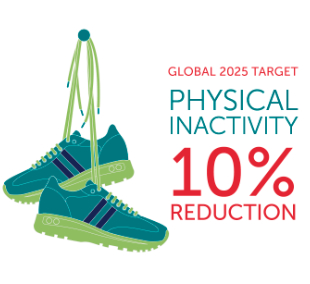@exerciseworks guest blog series on physical activity and cardiovascular health: Part 1
Daily life in the 21st century, often limits our health outcomes and aspirations. Our world: whatever nation we are part of, and the communities in which we live, together with our loved ones, have stopped moving at the levels of physical activity consistent with daily health. Urbanization, sedentary lifestyles, poverty, obesogenic environments, poor access to healthy food choices are all examples of how the global epidemic of inactivity and the pandemic health burden of non-communicable diseases (NCDs).
The World Health Organisation believes that more than 60% of the global population is not sufficiently active. In fact, inactivity is the world’s 4th biggest killer. The link between inactivity and heart and stroke disease is well documented. The total number of deaths due to heart and stroke disease is now over 17.3 million a year. Today, in your clinic, hospital ward, or community dwelling there are patients at risk of heart disease and premature death. That loss of diversity and life’s potential is no longer acceptable as an outcome for heart health.
 Physical activity, at any age, for any gender, within all cultures and ethnicities, within any ability, can protect your patient against a multitude of chronic health problems, including many forms of heart and stroke disease. Exercise works by regulating and maintaining weight and improving the body’s use of insulin. It also reduces the body’s inflammatory responses thought to increase the risks of a variety of NCDs. In 2012, we asked all health professionals to help encourage their patients to become more physically active and to embrace the concept of exercise as a ‘vital sign’ in their daily, clinical practice. This is because the known health benefits were becoming clinically clear: asking your patients to exercise for at least 150 minutes a week, significantly reduces their risk of chronic diseases, especially heart and stroke disease. Most importantly, it makes patients feel in control of their health, able to move without pain and discomfort, reduces their risks of disability and significantly improves their quality of life. For the secondary prevention of heart disease, the evidence for physical activity shows it is effective in reducing cardiovascular risk.
Physical activity, at any age, for any gender, within all cultures and ethnicities, within any ability, can protect your patient against a multitude of chronic health problems, including many forms of heart and stroke disease. Exercise works by regulating and maintaining weight and improving the body’s use of insulin. It also reduces the body’s inflammatory responses thought to increase the risks of a variety of NCDs. In 2012, we asked all health professionals to help encourage their patients to become more physically active and to embrace the concept of exercise as a ‘vital sign’ in their daily, clinical practice. This is because the known health benefits were becoming clinically clear: asking your patients to exercise for at least 150 minutes a week, significantly reduces their risk of chronic diseases, especially heart and stroke disease. Most importantly, it makes patients feel in control of their health, able to move without pain and discomfort, reduces their risks of disability and significantly improves their quality of life. For the secondary prevention of heart disease, the evidence for physical activity shows it is effective in reducing cardiovascular risk.
So, when you see your patient during your consultations as a doctor or allied health professional, what are your clinical decisions going to be, today? Are you going to champion the best medical evidence to date and prescribe a graduated dose of medical treatment in the form of exercise? Or are you going to ‘disable’ the patient by not addressing a root cause of their ill health, by not prescribing a medicine (such as exercise), which in fact, works better than most medicines, especially in heart disease and stroke?
As part of brief intervention, you can choose a specific exercise prescription, which supports and prevents your patient from the risks of inactivity and significant ill health, and lowers their risk of heart disease.
Helping them to exercise, daily, within their abilities, environments, lifestyle, and do whatever it takes to save their life from disability and further risks of cardiovascular disease is a critical medical intervention. As an example, a middle aged woman, doing less than 60 minutes of exercise per week, doubles her risk of dying from a cardiovascular event compared to a physically active woman of the same age. If that minimally active woman was a loved one, wouldn’t you want someone to help and support her to get physically active?
 A basic form of brief intervention, is to ask your patients to start a daily, walking programme, and sit much, much, less. Suggest they aim for at least 150 minutes each week of moderate ‘effort’ exercise. Follow up with each patient, at each visit, on that exercise advice. Monitor the exercise prescription.
A basic form of brief intervention, is to ask your patients to start a daily, walking programme, and sit much, much, less. Suggest they aim for at least 150 minutes each week of moderate ‘effort’ exercise. Follow up with each patient, at each visit, on that exercise advice. Monitor the exercise prescription.
By choosing to prescribe a medicine that’s evidence based, easy to take, has few harmful side effects, and great health outcome data, you can feel that you have excelled in your clinical practice. Patients may be reluctant to take your advice and the medicine. But if you were an oncologist, and your patient needed the best cancer treatment, you’d persuade them to accept chemotherapy based on the clinical evidence. So why is inactivity and heart disease prevention any different?
All health professionals can be and make the difference: to help reduce physical inactivity by 10% and help your clinical specialty colleagues, to confidently prescribe a range of disease specific exercises for all suitable patients. This, in conjunction with the medical treatments, will provide an effective approach to improving patient and public health, and be a combined strategy to reducing inactivity in patients with chronic diseases.
By encouraging patients to be more active on a daily basis and helping them choose to improve their leisure physical activities and maybe even try a sporting activity, this new approach has the ability to trend healthier lifestyles within your communities. Perhaps, one day you will realise that by prescribing exercise for your patient, you have helped save their life.
Heart health is important. It is essential that all patients are supported to enjoy daily exercise and physical activities that reduce their risks of heart disease. Help patient’s ask for support to access exercises of their choice, from their health and social care provider.
Globally, the Champion Advocates Programme is a World Heart Federation (WHF) initiative whose goal is to reduce premature deaths caused by cardiovascular disease (CVD) by 25% by 2025. It’s an ambitious goal…..but one that I would love the health, sports and exercise communities to embrace and champion…. because, since when did doctors and allied health professionals, around the world, not rise to a significant clinical challenge and deliver world class medicine!
******************************************************************************
Ann Gates BPharm(Hons) MRPharmS
Founder of Exercise Works!
Member of the WHF Champion Advocates Programme – Emerging Leaders Programme.
Info graphics courtesy of the World Heart Federation Champion Advocates Programme.
